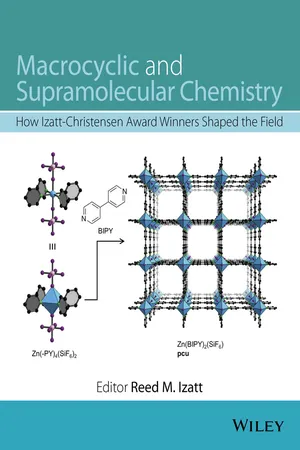
Macrocyclic and Supramolecular Chemistry
How Izatt-Christensen Award Winners Shaped the Field
Reed M. Izatt, Reed M. Izatt
- English
- ePUB (mobile friendly)
- Available on iOS & Android
Macrocyclic and Supramolecular Chemistry
How Izatt-Christensen Award Winners Shaped the Field
Reed M. Izatt, Reed M. Izatt
About This Book
This book commemorates the 25th anniversary of the International Izatt-Christensen Award in Macrocyclic and Supramolecular Chemistry. The award, one of the most prestigious of small awards in chemistry, recognizes excellence in the developing field of macrocyclic and supramolecular chemistry
Macrocyclic and Supramolecular Chemistry: How Izatt-Christensen Award Winners Shaped the Field features chapters written by the award recipients who provide unique perspectives on the spectacular growth in these expanding and vibrant fields of chemistry over the past half century, and on the role of these awardees in shaping this growth. During this time there has been an upsurge of interest in the design, synthesis and characterization of increasingly more complex macrocyclic ligands and in the application of this knowledge to understanding molecular recognition processes in host-guest chemistry in ways that were scarcely envisioned decades earlier. In October 2016, Professor Jean-Pierre Sauvage and Sir J. FraserStoddart (author for chapter 22 " Contractile and Extensile Molecular Systems: Towards Molecular Muscles" by Jean -Pierre Sauvage, Vincent Duplan, and Frédéric Niess and 20 " Serendipity" by Paul R. McGonigal and J. Fraser Stoddart respectively) were awarded the Nobel Prize in Chemistry alongside fellow Wiley author Bernard Feringa, for the design and synthesis of molecular machines.
Frequently asked questions
Information
1
The Izatt–Christensen Award in Macrocyclic and Supramolecular Chemistry: A 25-Year History (1991–2016)
1.1 Introduction
Table of contents
- Cover
- Title Page
- Table of Contents
- List of Contributors
- Preface
- Acknowledgements
- 1 The Izatt–Christensen Award in Macrocyclic and Supramolecular Chemistry
- 2 Supramolecular Chemistry with DNA
- 3 Anion, Cation and Ion-Pair Recognition by Macrocyclic and Interlocked Host Systems
- 4 Perspectives in Molecular Tectonics
- 5 Three Tales of Supramolecular Analytical Chemistry
- 6 Robust Host–Guest Chemistry of Cucurbit[n]uril
- 7 Molecular Recognition in Biomimetic Receptors
- 8 A Lifetime Walk in the Realm of Cyclam
- 9 Porosity in Metal–Organic Compounds
- 10 Cyclodextrin-based Supramolecular Systems
- 11 Making the Tiniest Machines
- 12 Clipping an Angel’s Wings
- 13 From Lanthanide Shift Reagents to Molecular Knots
- 14 Texaphyrins
- 15 Macrocyclic Coordination Chemistry of Resorcin[4]arenes and Pyrogallol[4]arenes
- 16 Dynamic Control of Recognition Processes in Host–Guest Systems and Polymer–Polymer Interactions
- 17 Cation Binders, Amphiphiles, and Membrane Active Transporters
- 18 Supramolecular Technology
- 19 Synthesis of Macrocyclic Complexes Using Metal Ion Templates
- 20 Serendipity
- 21 Evolution of ZnII–Macrocyclic Polyamines to Biological Probes and Supramolecular Assembly
- 22 Contractile and Extensile Molecular Systems
- Index
- End User License Agreement